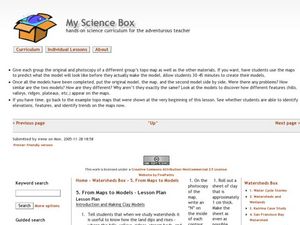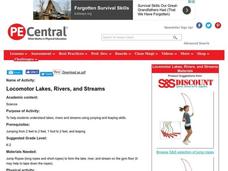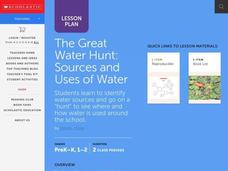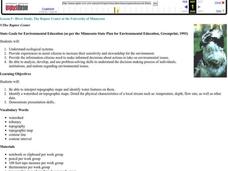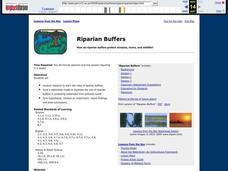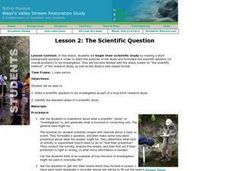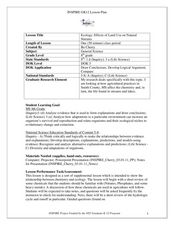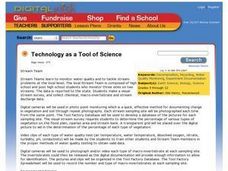Curated OER
Surface Water
In this surface water learning exercise, 6th graders will read 12 statements related to surface water and the movement of rivers over the land. In each statement, there is a bold-faced word that the students will unscramble and place...
Curated OER
From Maps to Models
Students explore watersheds through the use of a topographic map. They observe topographical maps and discuss their characteristics. In groups, students create a model clay island and make a topographical map of it. Afterward, groups...
Curated OER
Shedding Light on Watersheds
High schoolers discuss what a watershed is, complete online activities showing them how to take care of a watershed, and create a model of a watershed that they experiment with to see what happens when it is disrupted by civilization.
Curated OER
Locomotor Lakes, Rivers, and Streams
Learners explain lakes, rivers and streams using jumping and leaping skills. This integrated lesson plan reinforce scientific knowledge of ponds, rivers, lakes and streams.
Curated OER
Why Is Our Stream Changing?
Students test turbidity, pH, oxygen content and temperature of local stream. In this earth science instructional activity, students collect and record data from the experiment. They analyze findings and present it to class.
Curated OER
Using A Volunteer Acquired Database Constructed On The Internet, Examine the Relationship between Dissolved Oxygen and Water Temperature
Ninth graders access a database and open a spreadsheet. In this oxygen and water temperature lesson students save the database, sort it and generate scatter plot graphs.
Curated OER
Exploring Our Watershed System
Students study watersheds and examine how they are composed. In this watershed system lesson students explain how water enters a watershed and the concept of stream order.
Curated OER
Questions About Rivers
Students investigate rivers. In this geography lesson, students work in cooperative groups to read about rivers from articles they have collected. Students form questions using Bloom's Taxonomy as a guide.
Curated OER
Water Velocity
In this water learning exercise, learners use a graph comparing particle diameter with stream velocity to complete 6 fill in the blank questions.
Curated OER
The Great Water Hunt
Students create a model of the land to water ratio in a large group and search for all the places water is used at their school while on a Great Water Hunt. They identify where water can be found and compare how much of world is covered...
Curated OER
The Impact of the Physical Environment on Stream Macroinvertebrates
Young scholars explore the relationship between leaf packs in streams and macroinvertebrate populations. They experiment with hand exposure to stream macroinvertebrates in natural leaf packs and then make leaf packs of their own. The...
Curated OER
A "Sedimental" Journey-Sediment Collection
Students are asked how they would gather a sample of sediment from a lake, stream, river, pond, or swamp. They discuss safety concerns involving sample collections. Students are instructed to stay out of the water and to be careful not...
Curated OER
Stream Watch
Students discuss why it is important to take care of streams, what is non-point source and point source pollution, what are some causes of pollution in streams, and what can we do to prevent some of these causes of pollution? They steam...
Curated OER
Know Your Watershed
Students investigate the importance and the location of their own watershed by visiting and EPA website and also work in groups to create an action plan on how to protect their local watershed.
Curated OER
Determine Dischare of Stream
Students can explain that stream discharge defines the amount of water that passes a point in a given amount of time. They also define discharge is expressed as cubic feet/second is calculated as: average width of channel in feet x...
Curated OER
Field Work
Students realize that everyone lives in a watershed and that water is a fundamental life sustaining resource, they investigate ways to look at surface streams for quantity and quality of this vital resources. Students construct a...
Curated OER
River Study
Pupils explore a stream in their area and show the class the topographic map of the stream. They locate the topographic map and name the streams, lakes and ponds in their watershed. They write a paragraph about their stream and complete...
Curated OER
Riparian Buffers
Students research the roles of riparian buffers and create a model that shows the role of the buffers in protecting waterways from pollution. They conduct an experiment from which they record their data in this unit which is spread over...
Curated OER
Oceanography (Rivers and Streams)
Second graders examine the characteristics of streams and rivers. They identify the types of resources lakes, ponds and oceans provide. They ask questions to complete the lesson.
Curated OER
The Scientific Question
Young scholars identify the steps in the scientific method and discuss how each step is implemented. They examine a study of a stream on Kaua'i and analyze the scientific method in action.
Curated OER
BIOASSESSMENT OF STREAMS
Learners work as a team to gather organisms from a stream to evaluate if the water quality is excellent, good, or fair to poor.
Curated OER
Ecology: Effects of Land Use on Natural Streams
Eighth graders examine how humans affect various ecosystems. In this ecology instructional activity, 8th graders discuss different ways that contaminants enter the stream. They explain the consequences of eutrophication in lakes.
Curated OER
Exploring the "Our Rivers" Section
In this rivers activity, students access a website to answer questions about the Fraser River watershed in British Columbia. This activity has 8 short answer questions.
Curated OER
Technology as a Tool of Science
Students monitor streams, take stream surveys, collect chemical and macro-invertebrate and stream discharge data. Using a digital camera, students observe the percentage of various types of vegetation on the flood plan, riparian area and...



